A Grid-Interfaced DC Microgrid-Enabled Charging Infrastructure for Empowering Smart Sustainable Cities and Its Impacts on the Electrical Network: An Inclusive Review
Highlights
- The challenges associated with transportation electrification, grid-integrated DC microgrids, and universal standards to be followed for EV integration with the grid are explored comprehensively.
- The positive and negative impacts of EV charging infrastructure on the utility grid are discussed in detail. A case study is performed to analyse the negative impacts of EV load on the voltage profile and power loss of the IEEE 33 bus distribution system.
- The grid-integrated DC microgrid-enabled charging infrastructure offers decentralised energy governance. The universal standards for EV integration with the grid create a need for global collaboration among automakers and utilities.
- The need for voltage regulation devices, smart charging, power quality monitoring, and sustainable energy sources is emphasised in grid-integrated DC microgrid-based charging infrastructure.
Abstract
1. Introduction
1.1. Background
1.2. Critical Analysis of Existing Research
1.2.1. Various Energy Sources in the Microgrid
1.2.2. AC Microgrid-Based Charging Station
1.2.3. DC Microgrid-Based Charging Station
1.2.4. Grid-Integrated DC Microgrid-Based Charging Station
| Ref. | EVCS | MG-Based CS | Grid-Integrated MG-Based CS | Impacts | Voltage Profile | Power Loss | |
|---|---|---|---|---|---|---|---|
| Negative | Positive | ||||||
| [2] | ✓ | ✓ (Power quality and stability) | |||||
| [5] | ✓ | ✓ | ✓ (DC MG) | ||||
| [6] | ✓ | ✓ | |||||
| [7] | ✓ | ✓ | |||||
| [8] | ✓ | ✓ | |||||
| [18] | ✓ | ✓ | ✓ (AC MG) | ||||
| [22] | ✓ | ✓ | ✓ (DC MG) | ||||
| [24] | ✓ | ✓ | ✓ (DC MG) | ||||
| [25] | ✓ | ✓ | ✓ (DC MG) | ✓ (Protection issues) | ✓ (Energy management) | ||
| [27] | ✓ | ||||||
| [32] | ✓ | ✓ (Overloading, voltage profile) | ✓ (Grid upgradation) | ||||
| Present work | ✓ | ✓ | ✓ (DC MG) | ✓ (Voltage profile, power loss) | ✓ (Power management) | ✓ | ✓ |
1.2.5. Research Gap and Major Contributions
- The importance of transportation electrification is highlighted with different types of EVs, benefits, and challenges. Various factors limiting the adoption of transportation electrification are also discussed.
- Various energy sources in the MG and grid-integrated DC microgrid and universal standards to be followed for EV integration with the grid are discussed in detail.
- This paper aims to identify positive as well as negative impacts of EV charging infrastructure on the utility grid and to explore various methods to reduce the negative impacts of EVs on the electrical network.
- A case study is performed to show the major negative impacts of EV load on the distribution system. The impact on voltage profile and power loss of the IEEE 33 bus distribution system is analysed in three different cases of operations. This paper presents a cost comparison of AC versus DC microgrid-based charging infrastructure.
- This paper aims to address potential avenues in grid-integrated DC microgrid-based charging infrastructure and to outline the growing research directions for the future.
2. Transportation Electrification: Challenges and Opportunities
2.1. Electric Vehicle Types, Benefits, and Challenges
2.2. Electric Vehicle Charging Infrastructures
3. Overview of Microgrid Systems and Standards for Vehicle-to-Grid Integration
3.1. DC Microgrid
3.2. Various Energy Sources in the DC Microgrid
3.2.1. Solar Energy System
3.2.2. Wind Energy System
3.3. Grid-Integrated DC Microgrid
3.4. Standards for EV Integration with Grid
4. Assessment of EV Charging Effects on the Electrical Network
4.1. Negative Impacts of EVs on the Electrical Network
4.2. Positive Impacts of EVs on the Electrical Network
4.3. Case Study: Negative Externalities of EV Penetration and Cost Comparison of AC/DC Charging Infrastructure
5. Methods to Reduce the Negative Impact of CIs on the Utility Grid
6. Conclusions
Author Contributions
Funding
Data Availability Statement
Acknowledgments
Conflicts of Interest
Abbreviations
| EVs | Electric vehicles |
| RESs | Renewable energy sources |
| EVCIs | Electric vehicle charging infrastructures |
| MG | Microgrid |
| PQ | Power quality |
| CS | Charging station |
| FC | Fuel cell |
| PHEVs | Plug-in hybrid electric vehicles |
| BSSs | Battery storage systems |
| ESS | Energy storage system |
| BEVs | Battery electric vehicles |
| ICE | Internal combustion engine |
| HEVs | Hybrid electric vehicles |
| ER-EVs | Extended-range EVs |
| DN | Distribution network |
| DFIG | Doubly fed induction generator |
| PMSG | Permanent magnet synchronous generator |
| VSF | Voltage sensitivity factor |
| FCPs | Fast charging points |
References
- Bibra, E.M.; Connelly, E.; Dhir, S.; Drtil, M.; Henriot, P.; Hwang, I.; Le Marois, J.B.; McBain, S.; Paoli, L.; Teter, J. Global EV Outlook 2022: Securing Supplies for an Electric Future. 2022. Available online: https://iea.blob.core.windows.net/assets/ad8fb04c-4f75-42fc-973a-6e54c8a4449a/GlobalElectricVehicleOutlook2022.pdf (accessed on 11 September 2024).
- Srivastava, A.; Manas, M.; Dubey, R.K. Electric vehicle integration’s impacts on power quality in distribution network and associated mitigation measures: A review. J. Eng. Appl. Sci. 2023, 70, 32. [Google Scholar] [CrossRef]
- Reguieg, Z.; Bouyakoub, I.; Mehedi, F. Integrated optimization of power quality and energy management in a photovoltaic-battery microgrid. Renew. Energy 2025, 241, 122358. [Google Scholar] [CrossRef]
- Ji, C. Design, techno-economic feasibility analysis, and sensitivity study of an off-grid hybrid microgrid for developing communities. Renew. Energy 2025, 239, 121956. [Google Scholar] [CrossRef]
- Sechilariu, M.; Molines, N.; Richard, G.; Martell-Flores, H.; Locment, F.; Baert, J. Electromobility framework study: Infrastructure and urban planning for EV charging station empowered by PV-based microgrid. IET Electr. Syst. Transp. 2019, 9, 176–185. [Google Scholar] [CrossRef]
- Savio Abraham, D.; Verma, R.; Kanagaraj, L.; Giri Thulasi Raman, S.R.; Rajamanickam, N.; Chokkalingam, B.; Marimuthu Sekar, K.; Mihet-Popa, L. Electric vehicles charging stations’ architectures, criteria, power converters, and control strategies in microgrids. Electronics 2021, 10, 1895. [Google Scholar] [CrossRef]
- Dhingra, K.; Singh, M. Frequency support in a micro-grid using virtual synchronous generator based charging station. IET Renew. Power Gener. 2018, 12, 1034–1044. [Google Scholar] [CrossRef]
- Marinescu, A.; Serban, I. A smart residential microgrid based on renewable energy sources with integrated electric vehicle charging station. In Proceedings of the 2018 International Symposium on Fundamentals of Electrical Engineering (ISFEE), Bucharest, Romania, 1–3 November 2018; pp. 1–5. [Google Scholar]
- Singh, G.K. Solar power generation by PV (photovoltaic) technology: A review. Energy 2013, 53, 1–13. [Google Scholar] [CrossRef]
- Manoharan, P.; Subramaniam, U.; Babu, T.S.; Padmanaban, S.; Holm-Nielsen, J.B.; Mitolo, M.; Ravichandran, S. Improved perturb and observation maximum power point tracking technique for solar photovoltaic power generation systems. IEEE Syst. J. 2020, 15, 3024–3035. [Google Scholar] [CrossRef]
- Esram, T.; Chapman, P.L. Comparison of photovoltaic array maximum power point tracking techniques. IEEE Trans. Energy Convers. 2007, 22, 439–449. [Google Scholar] [CrossRef]
- Tiwari, R.; Babu, N.R. Recent developments of control strategies for wind energy conversion system. Renew. Sustain. Energy Rev. 2016, 66, 268–285. [Google Scholar] [CrossRef]
- Thakur, A.; Panigrahi, S.; Behera, R.R. A review on wind energy conversion system and enabling technology. In Proceedings of the 2016 International Conference on Electrical Power and Energy Systems (ICEPES), Bhopal, India, 14–16 December 2016; pp. 527–532. [Google Scholar]
- Song, M.; Chen, K.; Zhang, X.; Wang, J. Optimization of wind turbine micro-siting for reducing the sensitivity of power generation to wind direction. Renew. Energy 2016, 85, 57–65. [Google Scholar] [CrossRef]
- Lucia, U. Overview on fuel cells. Renew. Sustain. Energy Rev. 2014, 30, 164–169. [Google Scholar] [CrossRef]
- Akinyele, D.; Olabode, E.; Amole, A. Review of fuel cell technologies and applications for sustainable microgrid systems. Inventions 2020, 5, 42. [Google Scholar] [CrossRef]
- Mtolo, S.N.; Saha, A.K. A review of the optimization and control strategies for fuel cell power plants in a microgrid environment. IEEE Access 2021, 9, 146900–146920. [Google Scholar] [CrossRef]
- Fouladi, E.; Baghaee, H.R.; Bagheri, M.; Gharehpetian, G.B. Smart V2G/G2V charging strategy for PHEVs in AC microgrids based on maximizing battery lifetime and RER/DER employment. IEEE Syst. J. 2020, 15, 4907–4917. [Google Scholar] [CrossRef]
- Memon, A.A.; Kauhaniemi, K. A critical review of AC Microgrid protection issues and available solutions. Electr. Power Syst. Res. 2015, 129, 23–31. [Google Scholar] [CrossRef]
- Justo, J.J.; Mwasilu, F.; Lee, J.; Jung, J.-W. AC-microgrids versus DC-microgrids with distributed energy resources: A review. Renew. Sustain. Energy Rev. 2013, 24, 387–405. [Google Scholar] [CrossRef]
- Hamanah, W.M.; Hossain, I.; Shafiullah, M.; Abido, M.A. AC microgrid protection schemes: A comprehensive review. IEEE Access 2023, 11, 76842–76868. [Google Scholar] [CrossRef]
- AbuElrub, A.; Hamed, F.; Saadeh, O. Microgrid integrated electric vehicle charging algorithm with photovoltaic generation. J. Energy Storage 2020, 32, 101858. [Google Scholar] [CrossRef]
- El-Shahat, A.; Sumaiya, S. DC-microgrid system design, control, and analysis. Electronics 2019, 8, 124. [Google Scholar] [CrossRef]
- Locment, F.; Sechilariu, M. Modeling and simulation of DC microgrids for electric vehicle charging stations. Energies 2015, 8, 4335–4356. [Google Scholar] [CrossRef]
- Kaur, S.; Kaur, T.; Khanna, R.; Singh, P. A state of the art of DC microgrids for electric vehicle charging. In Proceedings of the 2017 4th International Conference on Signal Processing, Computing and Control (ISPCC), Solan, India, 21–23 September 2017; pp. 381–386. [Google Scholar]
- Aluisio, B.; Dicorato, M.; Ferrini, I.; Forte, G.; Sbrizzai, R.; Trovato, M. Planning and reliability of DC microgrid configurations for Electric Vehicle Supply Infrastructure. Int. J. Electr. Power Energy Syst. 2021, 131, 107104. [Google Scholar] [CrossRef]
- Dicorato, M.; Forte, G.; Trovato, M.; Munoz, C.B.; Coppola, G. An integrated DC microgrid solution for electric vehicle fleet management. IEEE Trans. Ind. Appl. 2019, 55, 7347–7355. [Google Scholar] [CrossRef]
- Mahfouz, M.M.; Iravani, M.R. Grid-integration of battery-enabled dc fast charging station for electric vehicles. IEEE Trans. Energy Convers. 2019, 35, 375–385. [Google Scholar] [CrossRef]
- Wu, S.; Xu, Q.; Li, Q.; Yua, X.; Chen, B. Optimal EV charging control strategy based on DC microgrid. Energy Procedia 2016, 100, 243–247. [Google Scholar] [CrossRef]
- Ye, Z.; Gao, Y.; Yu, N. Learning to operate an electric vehicle charging station considering vehicle-grid integration. IEEE Trans. Smart Grid 2022, 13, 3038–3048. [Google Scholar] [CrossRef]
- Mohamed, A.A.; El-Sayed, A.; Metwally, H.; Selem, S.I. Grid integration of a PV system supporting an EV charging station using Salp Swarm Optimization. Sol. Energy 2020, 205, 170–182. [Google Scholar] [CrossRef]
- Dahiwale, P.V.; Rather, Z.H.; Mitra, I. A comprehensive review of smart charging strategies for electric vehicles and way forward. IEEE Trans. Intell. Transp. Syst. 2024, 25, 10462–10482. [Google Scholar] [CrossRef]
- Hu, J.; Lee, C.-K.; Lu, H.H.-C. Reconfigurable wireless power transfer systems for distance adaptation. In Proceedings of the 2019 IEEE International Symposium on Circuits and Systems (ISCAS), Sapporo, Japan, 26–29 May 2019; pp. 1–4. [Google Scholar]
- Wang, H.S.; Cheng, K.W.E.; Hu, J.F. An investigation of compensation networks for three-coil wireless power transfer. In Proceedings of the 2020 8th International Conference on Power Electronics Systems and Applications (PESA), Hong Kong, China, 7–10 December 2020; pp. 1–6. [Google Scholar]
- Wang, Z.; Hou, H.; Wei, R.; Li, Z. A Distributed Market-Aided Restoration Approach of Multi-Energy Distribution Systems Considering Comprehensive Uncertainties From Typhoon Disaster. IEEE Trans. Smart Grid 2025, 16, 3743–3757. [Google Scholar] [CrossRef]
- Kumar, P.; Channi, H.K.; Kumar, R.; Rajiv, A.; Kumari, B.; Singh, G.; Singh, S.; Dyab, I.F.; Lozanović, J. A comprehensive review of vehicle-to-grid integration in electric vehicles: Powering the future. Energy Convers. Manag. X 2025, 25, 100864. [Google Scholar] [CrossRef]
- Rao, S.P.; Olusegun, T.S.; Ranganathan, P.; Kose, U.; Goveas, N. Vehicle-to-Grid technology: Opportunities, challenges, and future prospects for sustainable transportation. J. Energy Storage 2025, 110, 114927. [Google Scholar] [CrossRef]
- Christensen, K.; Ma, Z.; Jørgensen, B. A scoping review on electric vehicle charging strategies with a technical, social, and regulatory feasibility evaluation. Renew. Sustain. Energy Rev. 2025, 211, 115300. [Google Scholar] [CrossRef]
- Leijon, J. Charging strategies and battery ageing for electric vehicles: A review. Energy Strat. Rev. 2025, 57, 101641. [Google Scholar] [CrossRef]
- Cong, P.; Wu, Y.; Wang, C. Real-time scheduling strategy for electric vehicles based on sliding window transmission optimization. In Proceedings of the 2023 IEEE International Conference on Mechatronics and Automation (ICMA), Harbin, China, 6–9 August 2023; pp. 1385–1389. [Google Scholar]
- Wu, N.; Xu, J.; Linghu, J.; Huang, J. Real-time optimal control and dispatching strategy of multi-microgrid energy based on storage collaborative. Int. J. Electr. Power Energy Syst. 2024, 160, 110063. [Google Scholar] [CrossRef]
- Roy, H.; Roy, B.N.; Hasanuzzaman, M.; Islam, M.S.; Abdel-Khalik, A.S.; Hamad, M.S.; Ahmed, S. Global advancements and current challenges of electric vehicle batteries and their prospects: A comprehensive review. Sustainability 2022, 14, 16684. [Google Scholar] [CrossRef]
- Sanguesa, J.A.; Torres-Sanz, V.; Garrido, P.; Martinez, F.J.; Marquez-Barja, J.M. A review on electric vehicles: Technologies and challenges. Smart Cities 2021, 4, 372–404. [Google Scholar] [CrossRef]
- Corti, F.; Iacono, S.D.; Astolfi, D.; Pasetti, M.; Vasile, A.; Reatti, A.; Flammini, A. A comprehensive review of charging infrastructure for Electric Micromobility Vehicles: Technologies and challenges. Energy Rep. 2024, 12, 545–567. [Google Scholar] [CrossRef]
- Alanazi, F. Electric Vehicles: Benefits, Challenges, and Potential Solutions for Widespread Adaptation. Appl. Sci. 2023, 13, 6016. [Google Scholar] [CrossRef]
- Einaddin, A.H.; Yazdankhah, A.S. A novel approach for multi-objective optimal scheduling of large-scale EV fleets in a smart distribution grid considering realistic and stochastic modeling framework. Int. J. Electr. Power Energy Syst. 2020, 117, 105617. [Google Scholar] [CrossRef]
- Sharma, G.; Sood, V.K.; Alam, M.S.; Shariff, S.M. Comparison of common DC and AC bus architectures for EV fast charging stations and impact on power quality. eTransportation 2020, 5, 100066. [Google Scholar] [CrossRef]
- Khan, W.; Ahmad, F.; Alam, M.S. Fast EV charging station integration with grid ensuring optimal and quality power exchange. Eng. Sci. Technol. Int. J. 2019, 22, 143–152. [Google Scholar] [CrossRef]
- Khalid, M.R.; Khan, I.A.; Hameed, S.; Asghar, M.S.J.; Ro, J.S. A comprehensive review on structural topologies, power levels, energy storage systems, and standards for electric vehicle charging stations and their impacts on grid. IEEE Access 2021, 9, 128069–128094. [Google Scholar] [CrossRef]
- Uddin, M.; Mo, H.; Dong, D.; Elsawah, S.; Zhu, J.; Guerrero, J.M. Microgrids: A review, outstanding issues and future trends. Energy Strat. Rev. 2023, 49, 101127. [Google Scholar] [CrossRef]
- Abbasi, M.; Abbasi, E.; Li, L.; Aguilera, R.P.; Lu, D.; Wang, F. Review on the microgrid concept, structures, components, communication systems, and control methods. Energies 2023, 16, 484. [Google Scholar] [CrossRef]
- Ahmed, M.; Meegahapola, L.; Vahidnia, A.; Datta, M. Stability and control aspects of microgrid Architectures—A comprehensive review. IEEE Access 2020, 8, 144730–144766. [Google Scholar] [CrossRef]
- Kumar, J.; Agarwal, A.; Singh, N. Design, operation and control of a vast DC microgrid for integration of renewable energy sources. Renew. Energy Focus 2020, 34, 17–36. [Google Scholar] [CrossRef]
- Modu, B.; Abdullah, P.; Sanusi, M.A.; Hamza, M.F. DC-Based microgrid: Topologies, control schemes, and implementations. Alex. Eng. J. 2023, 70, 61–92. [Google Scholar] [CrossRef]
- Prabhala, V.A.; Baddipadiga, B.P.; Fajri, P.; Ferdowsi, M. An overview of direct current distribution system architectures & benefits. Energies 2018, 11, 2463. [Google Scholar] [CrossRef]
- Pires, V.F.; Pires, A.; Cordeiro, A. DC microgrids: Benefits, architectures, perspectives and challenges. Energies 2023, 16, 1217. [Google Scholar] [CrossRef]
- Dragicevic, T.; Lu, X.; Vasquez, J.C.; Guerrero, J.M. DC microgrids—Part II: A review of power architectures, applications, and standardization issues. IEEE Trans. Power Electron. 2015, 31, 3528–3549. [Google Scholar] [CrossRef]
- Kumar, J.; Agarwal, A.; Agarwal, V. A review on overall control of DC microgrids. J. Energy Storage 2019, 21, 113–138. [Google Scholar] [CrossRef]
- Srinivasan, M.; Kwasinski, A. Control analysis of parallel DC-DC converters in a DC microgrid with constant power loads. Int. J. Electr. Power Energy Syst. 2020, 122, 106207. [Google Scholar] [CrossRef]
- Bharath, K.R.; Krishnan, M.M.; Kanakasabapathy, P. A review on DC microgrid control techniques, applications and trends. Int. J. Renew. Energy Res. 2019, 9, 1328–1338. [Google Scholar] [CrossRef]
- Gao, F.; Kang, R.; Cao, J.; Yang, T. Primary and secondary control in DC microgrids: A review. J. Mod. Power Syst. Clean Energy 2019, 7, 227–242. [Google Scholar] [CrossRef]
- Shaikh, M.R.S. A review paper on electricity generation from solar energy. Int. J. Res. Appl. Sci. Eng. Technol. 2017, 5, 1884–1889. [Google Scholar] [CrossRef]
- Gopi, A.; Sudhakar, K.; Keng, N.W.; Krishnan, A.R.; Priya, S.S. Performance modeling of the weather impact on a utility-scale PV power plant in a tropical region. Int. J. Photoenergy 2021, 2021, 5551014. [Google Scholar] [CrossRef]
- Huxley, O.; Taylor, J.; Everard, A.; Briggs, J.; Tilley, K.; Harwood, J.; Buckley, A. The uncertainties involved in measuring national solar photovoltaic electricity generation. Renew. Sustain. Energy Rev. 2022, 156, 112000. [Google Scholar] [CrossRef]
- Vargas, S.A.; Esteves, G.R.T.; Maçaira, P.M.; Bastos, B.Q.; Oliveira, F.L.C.; Souza, R.C. Wind power generation: A review and a research agenda. J. Clean. Prod. 2019, 218, 850–870. [Google Scholar] [CrossRef]
- Blaabjerg, F.; Chen, Z.; Kjaer, S.B. Power electronics as efficient interface in dispersed power generation systems. IEEE Trans. Power Electron. 2004, 19, 1184–1194. [Google Scholar] [CrossRef]
- Faraji, J.; Hashemi-Dezaki, H.; Ketabi, A. Optimal probabilistic scenario-based operation and scheduling of prosumer microgrids considering uncertainties of renewable energy sources. Energy Sci. Eng. 2020, 8, 3942–3960. [Google Scholar] [CrossRef]
- Bai, W.; Sechilariu, M.; Locment, F. DC microgrid system modeling and simulation based on a specific algorithm for grid-connected and islanded modes with real-time demand-side management optimization. Appl. Sci. 2020, 10, 2544. [Google Scholar] [CrossRef]
- Al-Ismail, F.S. DC microgrid planning, operation, and control: A comprehensive review. IEEE Access 2021, 9, 36154–36172. [Google Scholar] [CrossRef]
- Sanjeev, P.; Padhy, N.P.; Agarwal, P. Peak energy management using renewable integrated DC microgrid. IEEE Trans. Smart Grid 2017, 9, 4906–4917. [Google Scholar] [CrossRef]
- Das, H.S.; Rahman, M.M.; Li, S.; Tan, C.W. Electric vehicles standards, charging infrastructure, and impact on grid integration: A technological review. Renew. Sustain. Energy Rev. 2020, 120, 109618. [Google Scholar] [CrossRef]
- Kumar, M.; Panda, K.P.; Naayagi, R.T.; Thakur, R.; Panda, G. Comprehensive review of electric vehicle technology and its impacts: Detailed investigation of charging infrastructure, power management, and control techniques. Appl. Sci. 2023, 13, 8919. [Google Scholar] [CrossRef]
- Srivastava, M.; Goyal, S.K.; Saraswat, A.; Shekhawat, R.S.; Gangil, G. A Review on Power Quality Problems, Causes and Mitigation Techniques. In Proceedings of the 2022 1st International Conference on Sustainable Technology for Power and Energy Systems (STPES), Srinagar, India, 4–6 July 2022; pp. 1–6. [Google Scholar]
- Bajaj, M.; Singh, A.K. Grid integrated renewable DG systems: A review of power quality challenges and state-of-the-art mitigation techniques. Int. J. Energy Res. 2020, 44, 26–69. [Google Scholar] [CrossRef]
- Lim, K.L.; Speidel, S.; Bräunl, T. A comparative study of AC and DC public electric vehicle charging station usage in Western Australia. Renew. Sustain. Energy Transit. 2022, 2, 100021. [Google Scholar] [CrossRef]
- Memon, D.A.; Ali, K.H.; Memon, A.A.; Ansari, J.A.; Badar, J.; Alharbi, M.; Banatwala, A.Z.; Kumar, M. Comparative analysis and implementation of DC microgrid systems versus AC microgrid performance. Front. Energy Res. 2024, 12, 1370547. [Google Scholar] [CrossRef]

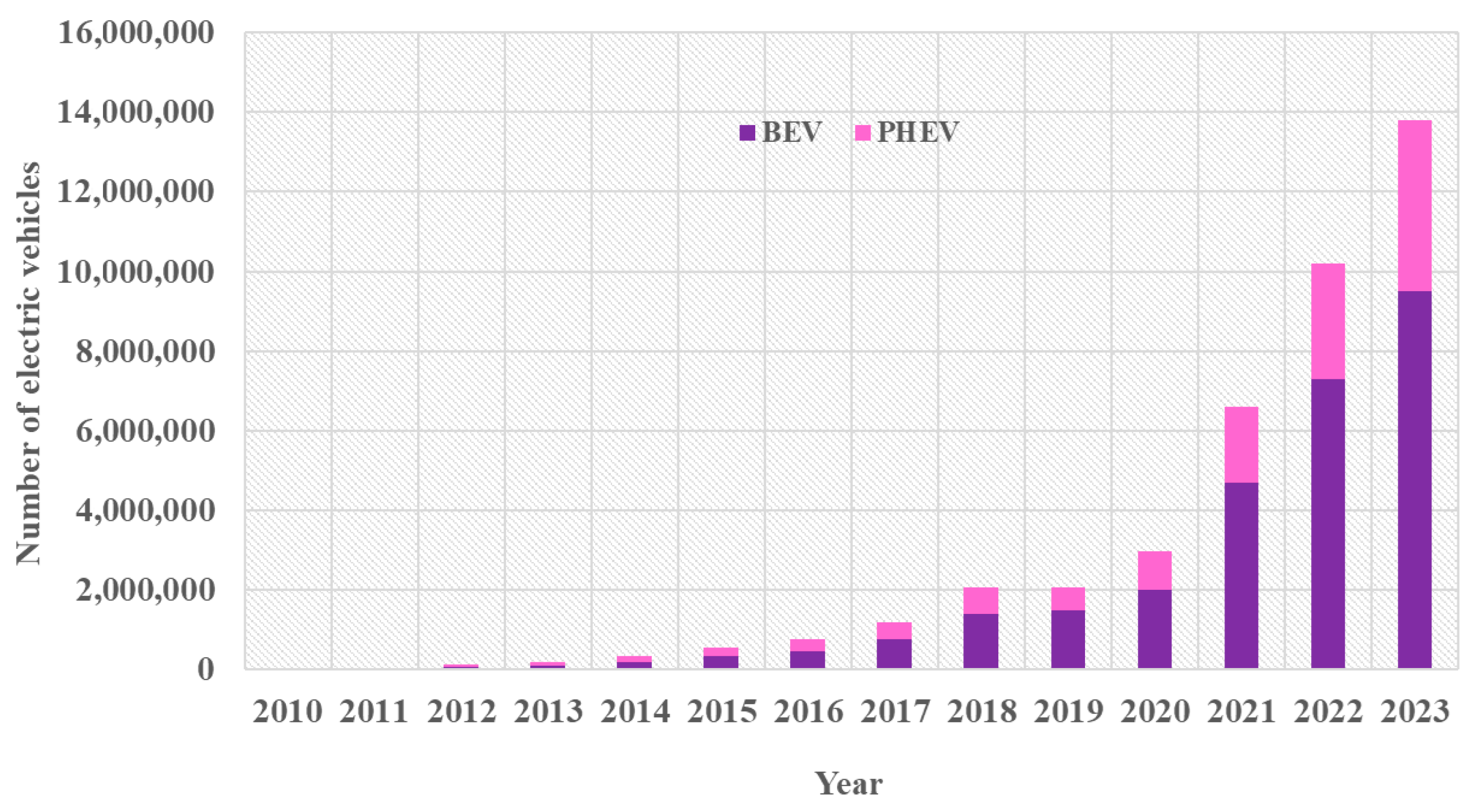

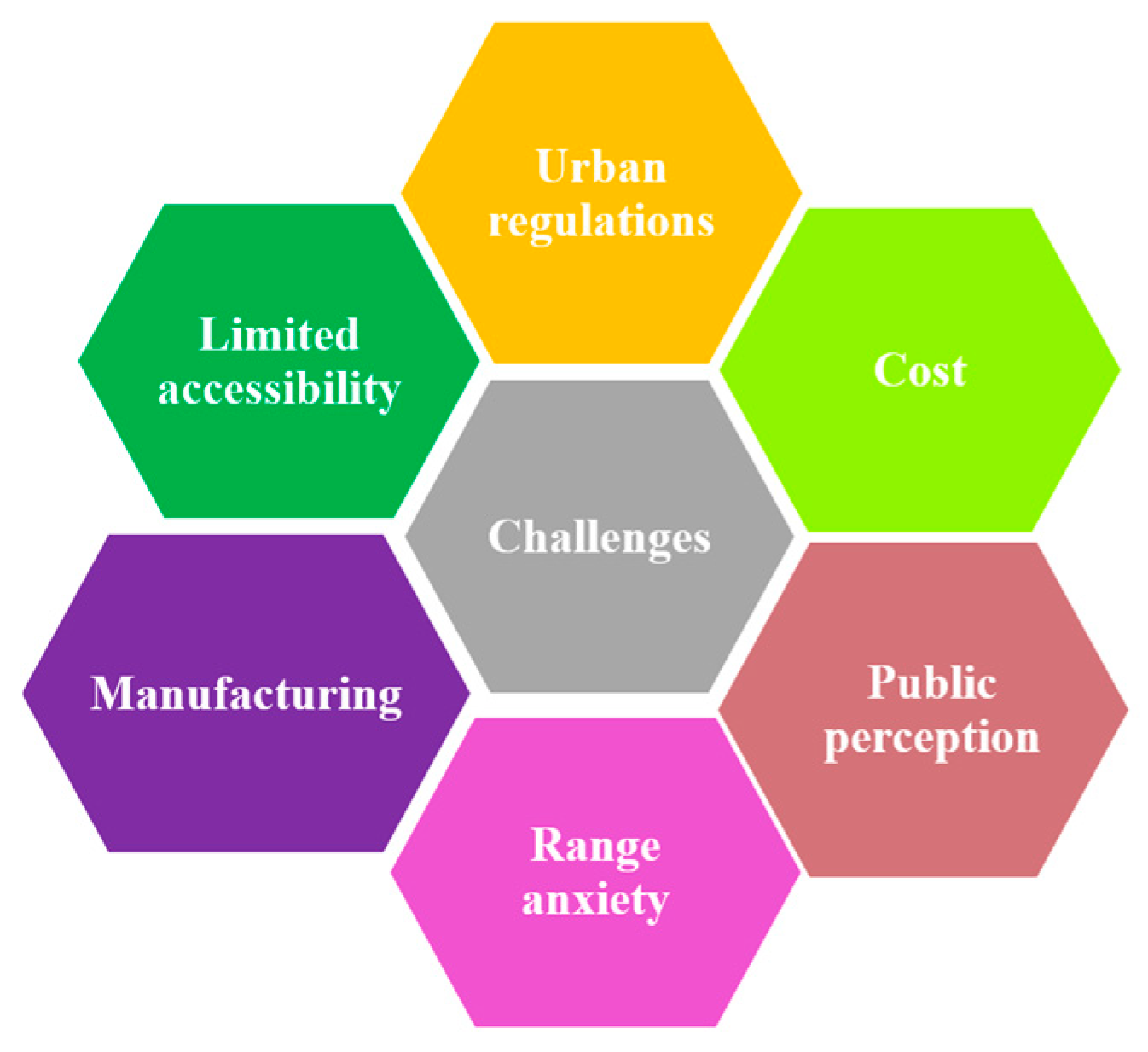

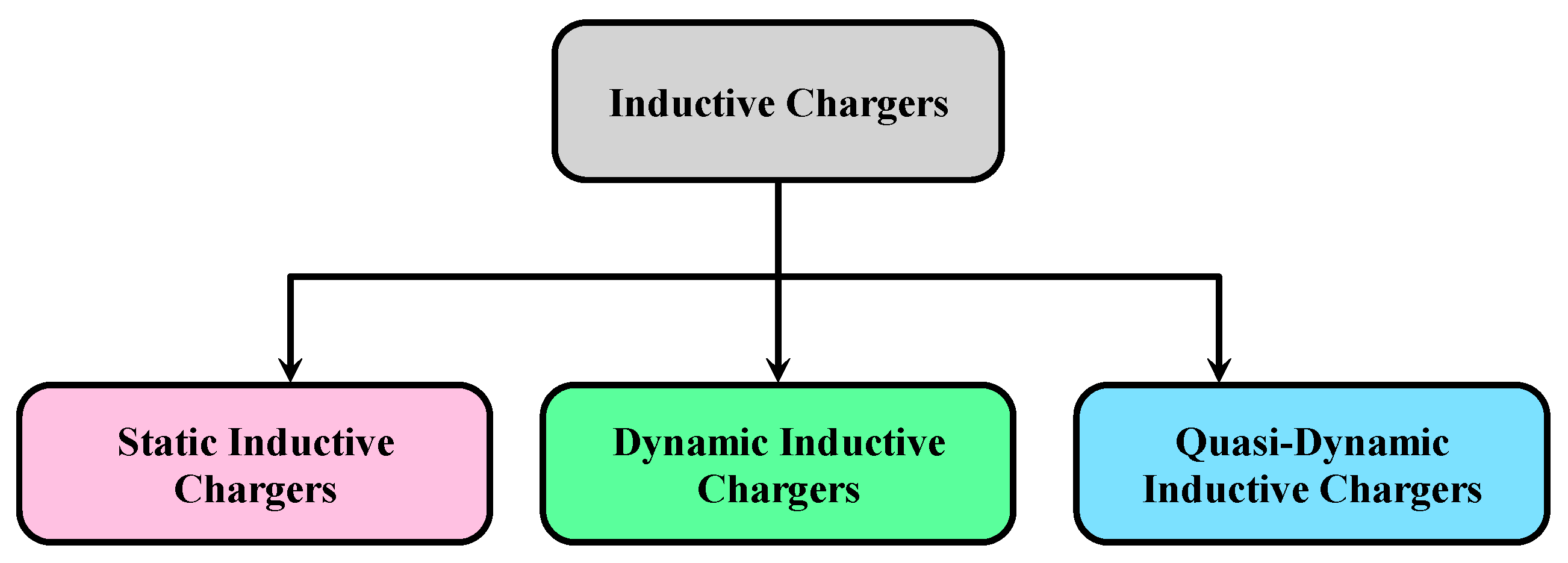
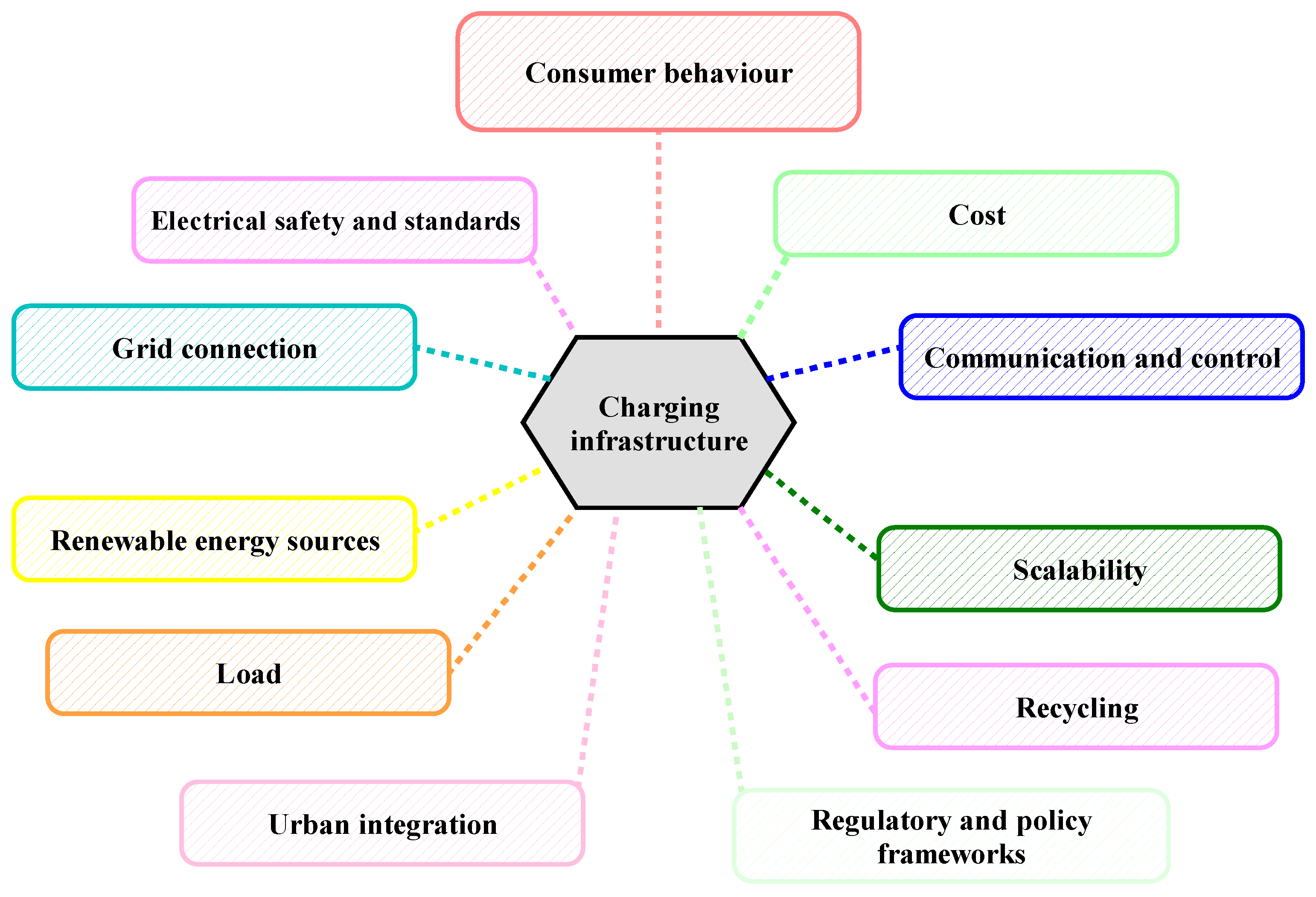
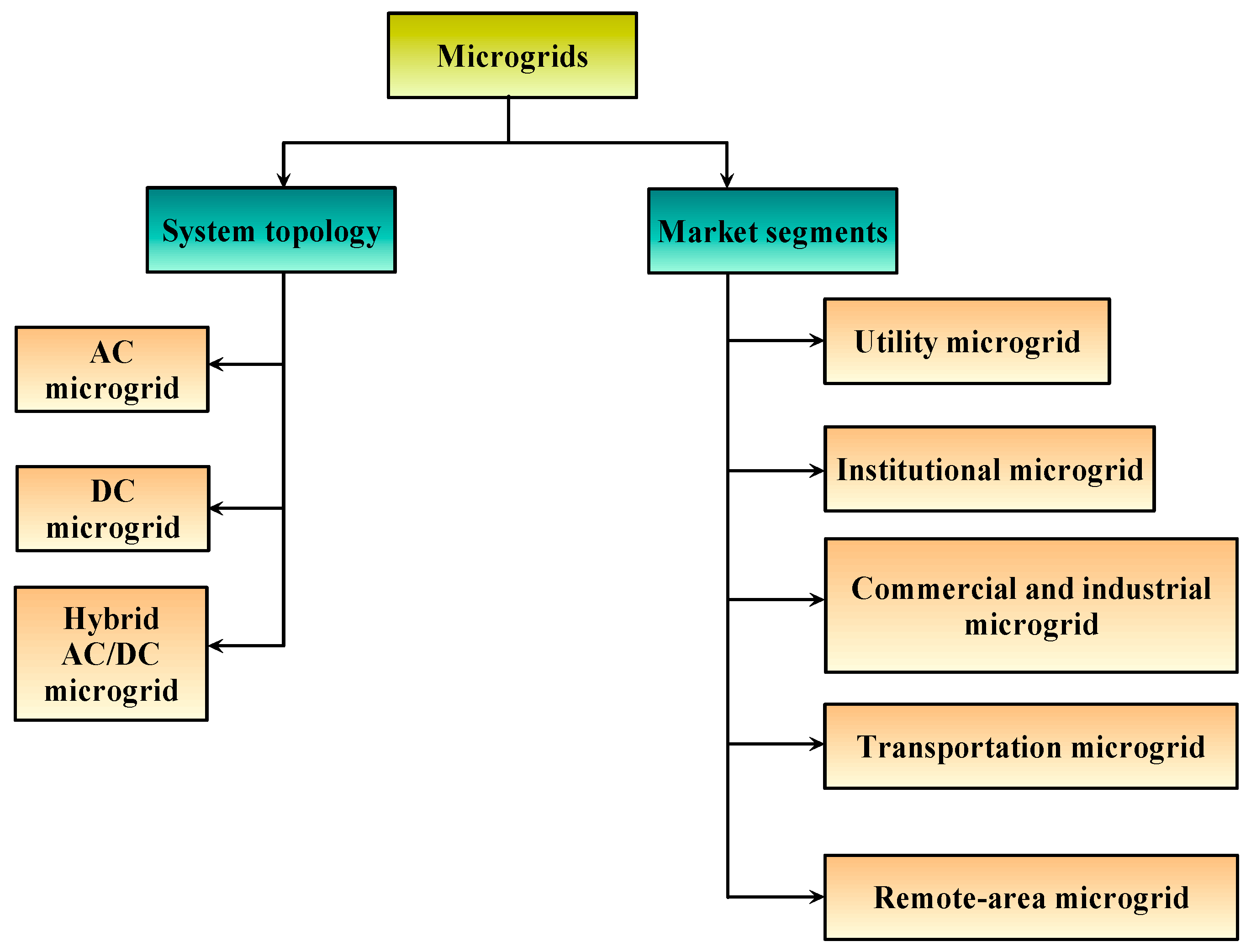


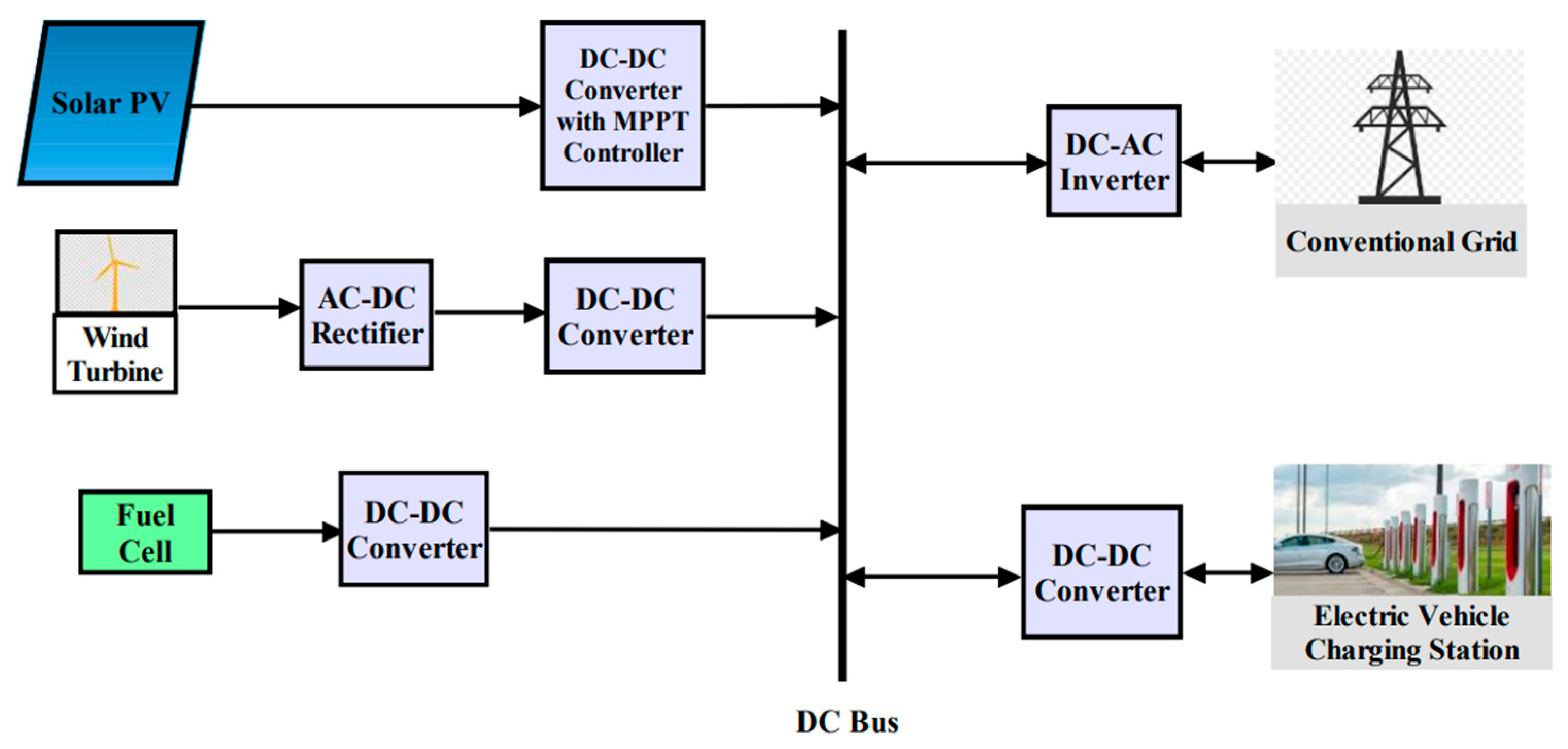

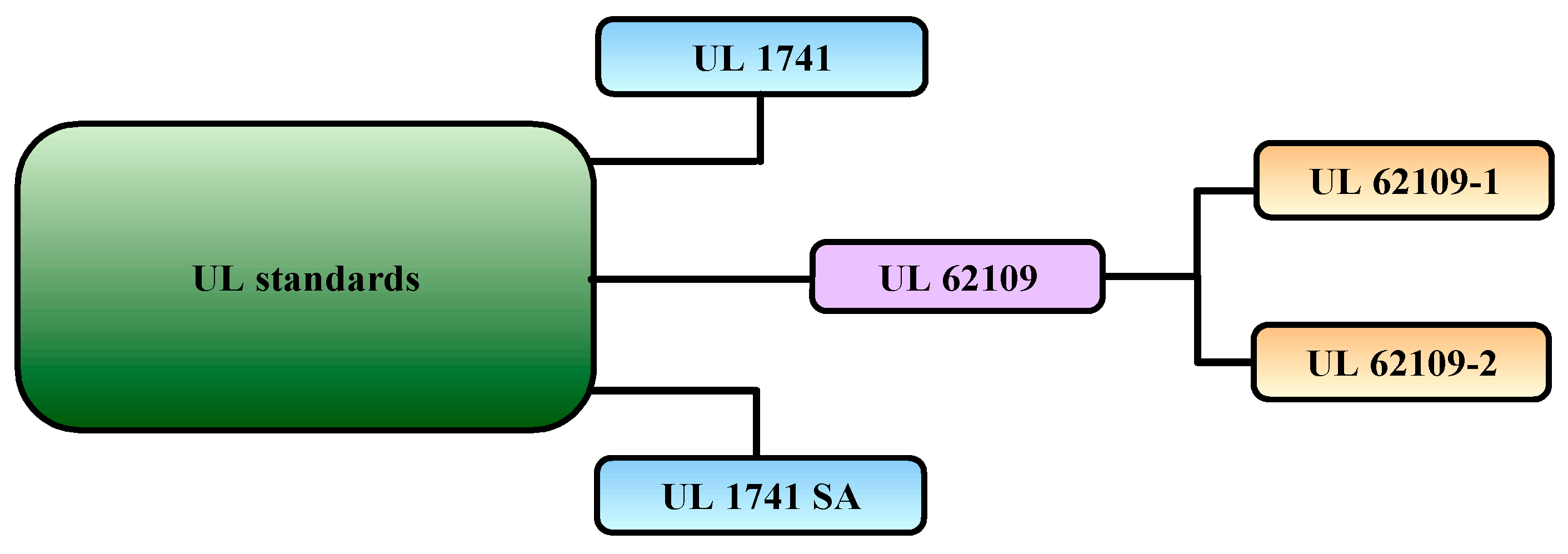


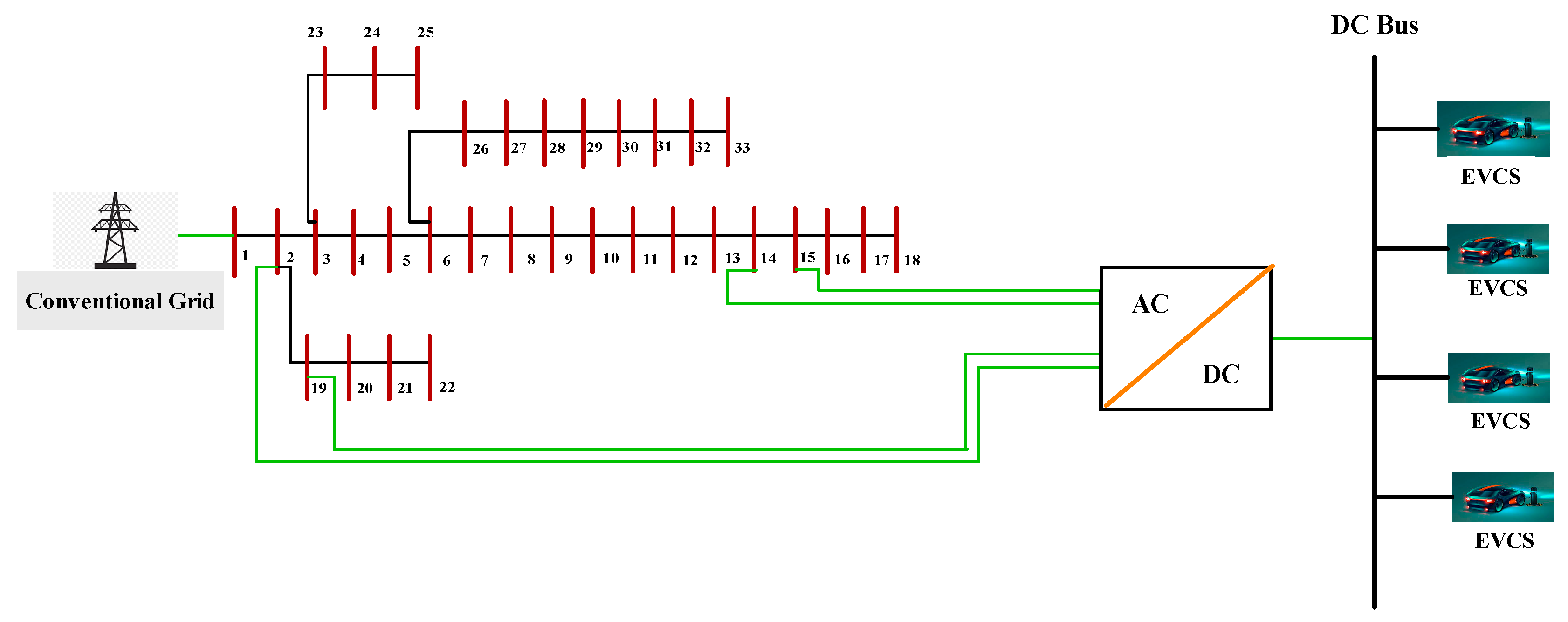
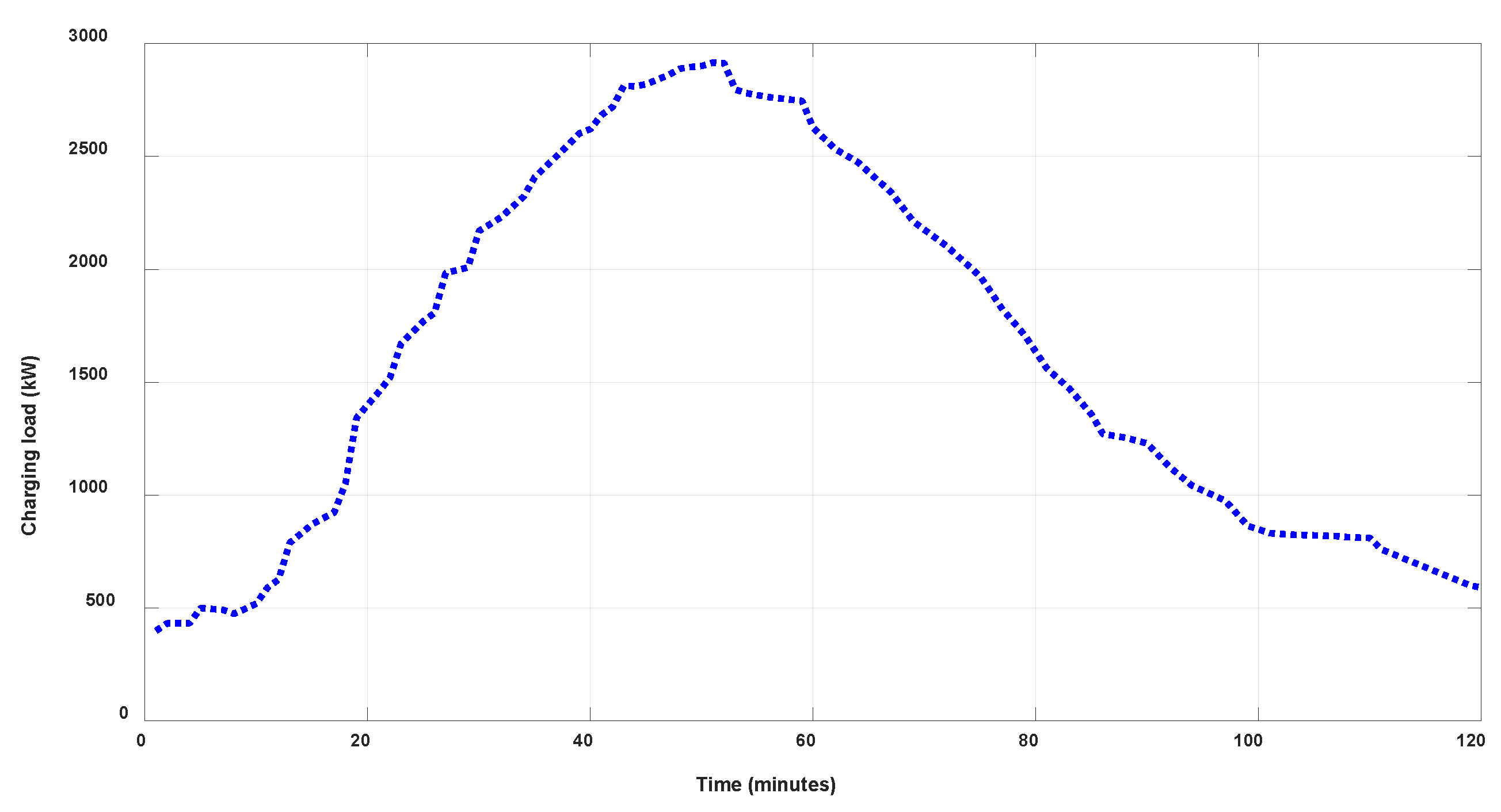
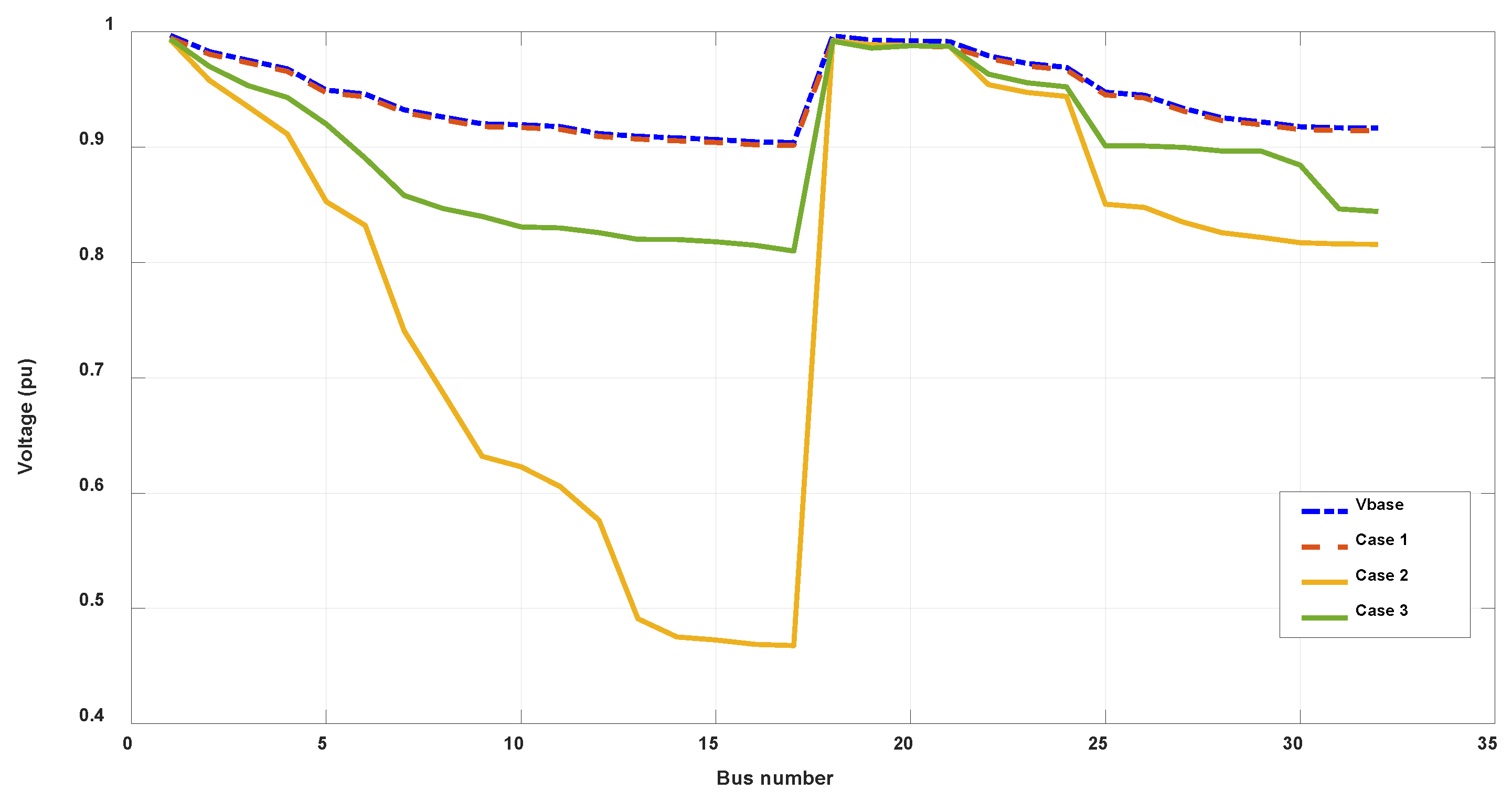
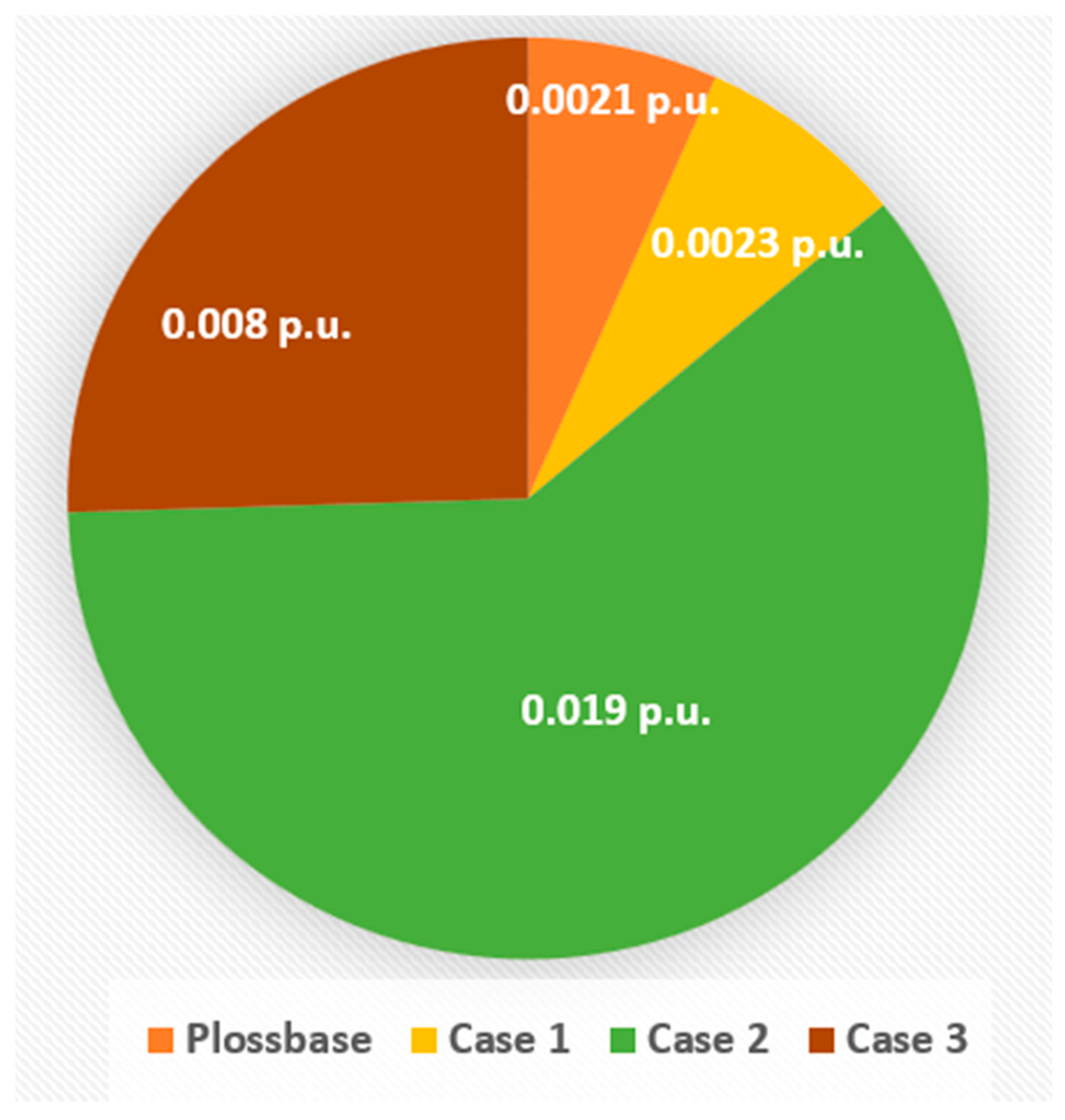
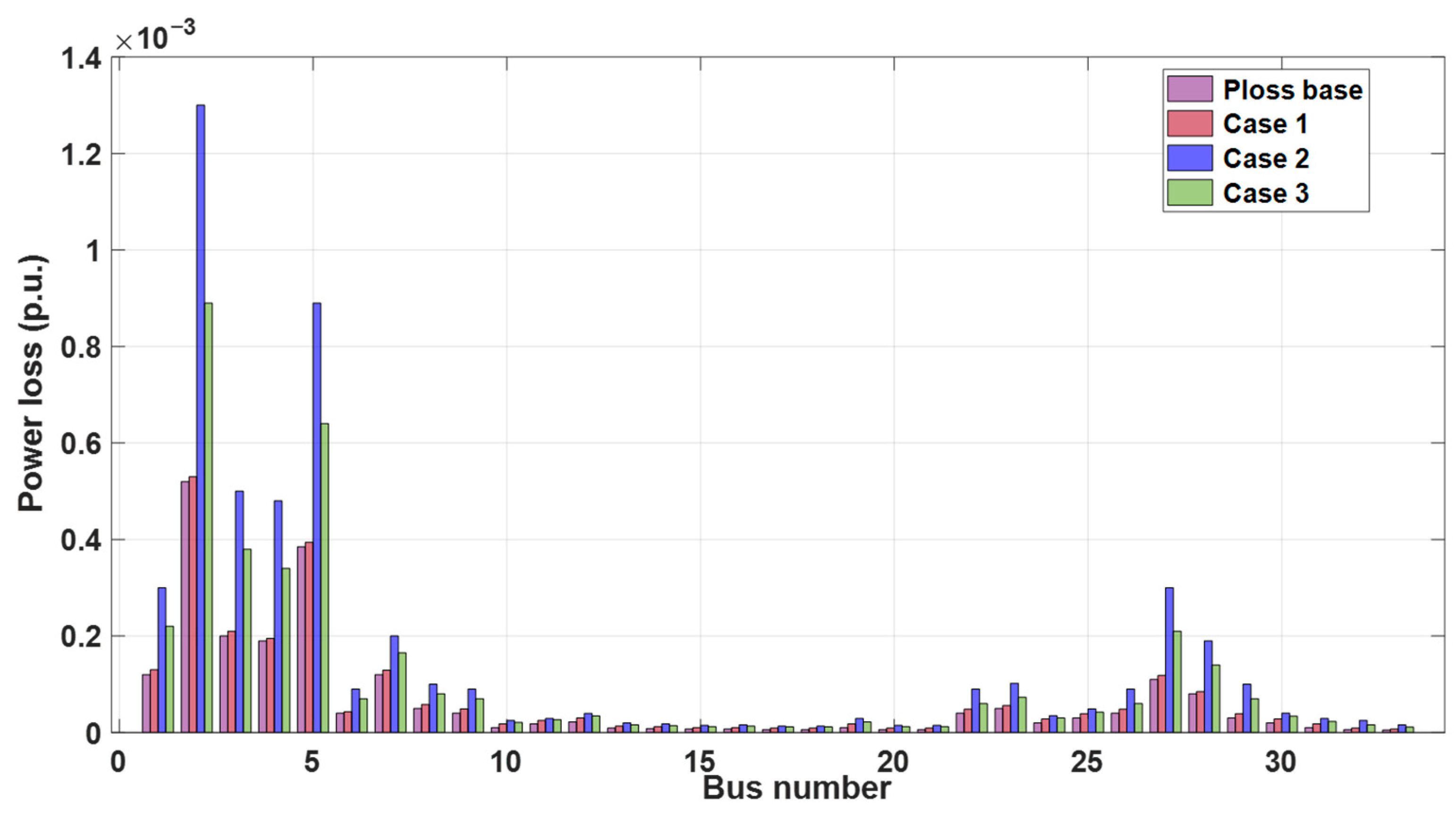
| Standards | Description |
|---|---|
| IEEE 1547 | It is applicable for interconnecting DERs with power systems. The requirements related to the operation, performance, safety, testing, installations, and maintenance of DERs on primary and secondary distribution systems are covered by this standard. |
| UL 1741 | Specifications for power conversion equipment and its protection devices for DER incorporation with the grid is covered by UL standards. |
| NFPA 70 | It provides guidelines for wiring electrical equipment and ensuring safety on the consumer side of PCC. |
| Sl. No. | Challenges | Causes | Possible Solutions |
| 1. | Voltage dip | Large motor operations, connection of heavy loads, and faults on the transmission and DN. | A voltage dip occurs when the nominal rms voltage is reduced at a power frequency between 10% and 90% for 0.5 cycles to 1 min. |
| 2. | Voltage swell | Interruption of large loads, capacitors, and single-phase loads. | A sudden increase in voltage beyond the standard tolerances at the power frequency, with more than one cycle duration but usually shorter than a few seconds. |
| 3. | Voltage spike | Lightning, switching of lines, and disconnection of heavy loads. | A rapid variation in voltage levels lasting anywhere from a few microseconds to a few milliseconds. |
| 4. | Harmonic distortion | Non-linear loads and transformer saturation. | A distortion of the sinusoidal waveform of the voltage or current due to the existence of higher-frequency components. |
| 5. | Voltage fluctuation | Varying loads. | A power frequency variation in the rms value of the voltage. |
| 6. | Voltage unbalance | Unbalanced loads, single-phase faults, and open conductors. | A fluctuation in the voltage magnitude or phase angle of the three-phase system. |
| 7. | Noise | Electromagnetic interference from radio transmitters, switching devices, and power electronics. | A superposition of high-frequency signals on the power system voltage or current. |
| 8. | Interruptions | Equipment failure, storms, human error, and protection devices. | A total loss of supply voltage or load current for a short or long duration. |
| Case | Description | Bus Number | Number of FCSs |
|---|---|---|---|
| Case 1 | Two FCSs are placed at two different strong buses | 2 and 19 | 2 |
| Case 2 | Two FCSs are placed at two different weak buses | 14 and 15 | 2 |
| Case 3 | One FCS is placed at a strong bus and one FCS is placed at a weak bus | 2 and 14 | 2 |
| Aspect | AC MG-Based Charging Station | DC MG-Based Charging Station |
|---|---|---|
| Infrastructure complexity | Lower due to the use of the existing utility grid for supply | Higher as it requires DC sources, converters, and energy balancing |
| Initial installation cost | INR 15 to 25 lakhs for level 2 AC chargers tied to the utility grid | INR 40 lakhs to 1 crore for DC fast chargers, including converters |
| Land and civil works | INR 5 to 10 lakhs for a smaller footprint | INR 15 to 25 lakhs for a larger footprint |
| Energy conversion losses | AC to DC conversion inside the vehicle is about 10–15% | Direct DC supply to the vehicle is about 5–7% |
| Power rating | 3–22 kW for slow to moderate charging | 50–350 kW for fast charging |
| Operation cost per kWh | INR 7–14 | INR 18–22 |
| Maintenance cost per year | INR 1–2 lakhs | INR 3–5 lakhs |
| Return on investment | 5 to 7 years for low-traffic zones | 2 to 4 years for high-traffic zones |
| Sl. No. | Method | Description | Limitations |
|---|---|---|---|
| 1. | Smart charging | The charging of EVs will be planned according to the obtainability of renewable energy or in the off-peak hours. | To deploy and maintain smart charging in Cis requires significant investment. Scalability of CIs. |
| 2. | Smart grid | The EVs can be charged and discharged in a coordinated way in smart grids, which automatically detect, monitor, and regulate the energy flow among power generators and energy users. | The uncertain EV charging load results in overloading of the transformers. |
| 3. | EV charging management system | The amount of energy drawn from the grids is minimised by the EV charging management system. | To manage the grid capacity during peak load demand is challenging. |
| 4. | Demand response | To reduce peak demand on the utility grids, EV owners need to be incentivised to charge their EVs in off-peak hours. | Interference with EV user convenience. |
| 5. | Vehicle to grid | The extra energy is supplied back to the grid during peak hours. | Effects on life and capacity of EV battery due to frequent charging and discharging. |
| 6. | Renewable energy sources | RESs can be used as a prime source to charge the EVs. | Uncertainties in power generation from renewables. |
| 7. | Battery storage | The excess energy produced from renewable sources is stored in the batteries and that can be utilised to meet the large demand of EVs. | Initial investment is high and battery degradation is a limitation. |
Disclaimer/Publisher’s Note: The statements, opinions and data contained in all publications are solely those of the individual author(s) and contributor(s) and not of MDPI and/or the editor(s). MDPI and/or the editor(s) disclaim responsibility for any injury to people or property resulting from any ideas, methods, instructions or products referred to in the content. |
© 2025 by the authors. Licensee MDPI, Basel, Switzerland. This article is an open access article distributed under the terms and conditions of the Creative Commons Attribution (CC BY) license (https://creativecommons.org/licenses/by/4.0/).
Share and Cite
Krishnamurthy, N.K.; Sabhahit, J.N.; Jadoun, V.K.; Pandey, A.K.; Rao, V.S.; Saraswat, A. A Grid-Interfaced DC Microgrid-Enabled Charging Infrastructure for Empowering Smart Sustainable Cities and Its Impacts on the Electrical Network: An Inclusive Review. Smart Cities 2025, 8, 176. https://doi.org/10.3390/smartcities8050176
Krishnamurthy NK, Sabhahit JN, Jadoun VK, Pandey AK, Rao VS, Saraswat A. A Grid-Interfaced DC Microgrid-Enabled Charging Infrastructure for Empowering Smart Sustainable Cities and Its Impacts on the Electrical Network: An Inclusive Review. Smart Cities. 2025; 8(5):176. https://doi.org/10.3390/smartcities8050176
Chicago/Turabian StyleKrishnamurthy, Nandini K., Jayalakshmi Narayana Sabhahit, Vinay Kumar Jadoun, Anubhav Kumar Pandey, Vidya S. Rao, and Amit Saraswat. 2025. "A Grid-Interfaced DC Microgrid-Enabled Charging Infrastructure for Empowering Smart Sustainable Cities and Its Impacts on the Electrical Network: An Inclusive Review" Smart Cities 8, no. 5: 176. https://doi.org/10.3390/smartcities8050176
APA StyleKrishnamurthy, N. K., Sabhahit, J. N., Jadoun, V. K., Pandey, A. K., Rao, V. S., & Saraswat, A. (2025). A Grid-Interfaced DC Microgrid-Enabled Charging Infrastructure for Empowering Smart Sustainable Cities and Its Impacts on the Electrical Network: An Inclusive Review. Smart Cities, 8(5), 176. https://doi.org/10.3390/smartcities8050176








